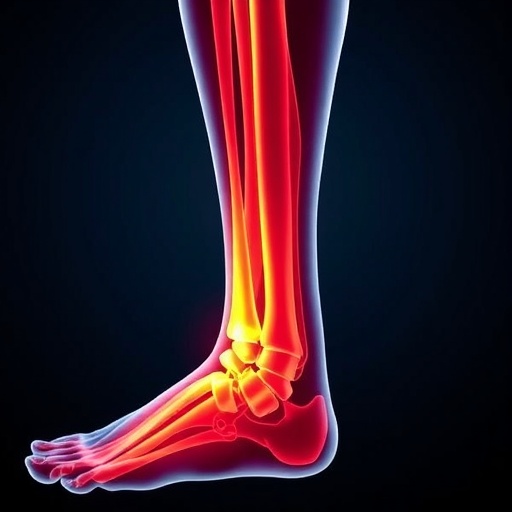In recent years, the field of pain management and rehabilitation has undergone significant transformations, contributing to our understanding of how we can effectively treat patients suffering from conditions such as diabetic peripheral neuropathy (DPN). A recent study published in BMC Complementary Medicine and Therapies by Ashoori et al. investigates the impact of tibial nerve neurodynamic techniques on neuropathy severity and quality of life among DPN patients, an area that has crucial implications for therapeutic practices involving rehabilitation.
Diabetic peripheral neuropathy is a debilitating condition affecting millions worldwide, manifesting as pain, tingling, and numbness in the extremities. Those affected are often caught in a vicious cycle of chronic pain that not only impacts physical mobility but also diminishes overall quality of life. Conventional pain management strategies have primarily focused on pharmacological interventions and physical therapy, yet they often yield mixed results. This gap in effective treatment has driven researchers to explore alternative methods that address underlying neuromuscular issues while also promoting rehabilitation.
In the study, researchers conducted a randomized sham-controlled trial, a gold standard in clinical research design, to ascertain the effectiveness of tibial nerve neurodynamic techniques. This approach involves specific movements and mobilizations of the tibial nerve that aim to restore proper function and alleviate compression or irritation that may be contributing to neuropathic symptoms. Neurodynamic techniques focus on the nervous system’s ability to move freely within the body, thus reducing tension that could impair nerve function.
Participants in the trial were carefully selected, representing a diverse group of individuals diagnosed with diabetic peripheral neuropathy. They were divided into two groups: one receiving the neurodynamic treatment alongside a standard rehabilitative pain management strategy and the other group receiving a sham treatment, which mimicked the procedure without delivering the intended therapeutic benefit. These methodological details underscore the rigor of the trial, ensuring that any observed outcomes can be attributed explicitly to the neurodynamic intervention.
Over the course of the study, participants underwent multiple sessions where they experienced personalized tibial nerve mobilization techniques. The trial incorporated assessment tools to measure changes in neuropathy severity and overall quality of life, with standardized questionnaires administered to gauge both subjective and objective outcomes. Evaluating participants at baseline, mid-intervention, and at follow-up revealed significant insights into the efficacy of the intervention.
Results indicated that those who received the tibial nerve neurodynamic techniques reported a remarkable improvement in neuropathy severity scores when compared to the control group. Moreover, the quality of life assessments illustrated a meaningful enhancement in daily living activities, social participation, and psychological well-being. These findings suggest that the neurodynamic techniques not only address the physical aspects of neuropathy but also incorporate a holistic perspective on patient care, addressing emotional and psychological factors associated with chronic pain.
The underlying mechanisms of how tibial nerve neurodynamics alleviates neuropathy symptoms are still under investigation. However, some hypotheses include reduced mechanical sensitivity, improved blood circulation to peripheral nerves, and restoration of neural mobility. This multifaceted approach provides a framework for further research into the nervous system’s adaptability and the body’s own healing capabilities.
Furthermore, the implications of this study extend beyond the immediate findings. With the relentless surge in diabetes rates globally, the demand for effective and non-invasive treatment modalities increases exponentially. This research offers a promising direction for clinicians and therapists seeking to expand their arsenal against diabetic peripheral neuropathy and related conditions. By integrating such techniques into existing rehabilitation frameworks, the healthcare community stands to foster improved patient outcomes and overall satisfaction.
As the landscape of medical research continues to evolve, the significance of trials like those conducted by Ashoori et al. cannot be overstated. Their work shines a light on the importance of exploring innovative solutions to persistent health challenges. Engaging with such methods paves the way for a new era in pain management, where patient-centric approaches are the norm rather than the exception.
Support from contemporary evidence-based practices will be necessary for broader acceptance of tibial nerve neurodynamic techniques in standard care. Continued collaboration between researchers and clinicians will foster an iterative process where findings from clinical trials translate into real-world applications. Education and training in neurodynamic techniques may also be necessary to equip healthcare professionals with the skills required to implement these strategies effectively.
In summary, the research by Ashoori and colleagues presents a compelling case for the integration of tibial nerve neurodynamic techniques into the treatment regimens for diabetic peripheral neuropathy. Their findings underscore an essential shift toward more comprehensive, empathetic, and effective approaches to pain management that prioritize the patient’s experience. The ongoing exploration of such interventions will hopefully continue to unveil new modalities that enhance both individual and community health outcomes.
As we look ahead, it is essential to remain optimistic about the evolution of therapeutic options in treating neuropathic pain. Collaborative efforts, innovative thinking, and a patient-focused philosophy will undoubtedly shape a future where conditions like diabetic peripheral neuropathy can be managed with greater effectiveness and compassion.
Subject of Research: The effects of tibial nerve neurodynamic techniques on neuropathy severity and quality of life in patients with diabetic peripheral neuropathy.
Article Title: Adding tibial nerve neurodynamic techniques to a rehabilitative pain management strategy improved neuropathy severity and quality of life in patients with diabetic peripheral neuropathy: a randomized sham-controlled trial.
Article References: Ashoori, M., Hashemi, S.E., Pourahmadi, M. et al. Adding tibial nerve neurodynamic techniques to a rehabilitative pain management strategy improved neuropathy severity and quality of life in patients with diabetic peripheral neuropathy: a randomized sham-controlled trial. BMC Complement Med Ther 25, 429 (2025). https://doi.org/10.1186/s12906-025-05168-3
Image Credits: AI Generated
DOI: https://doi.org/10.1186/s12906-025-05168-3
Keywords: diabetic peripheral neuropathy, tibial nerve neurodynamic techniques, pain management, rehabilitation, randomized controlled trial.




